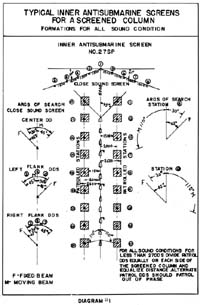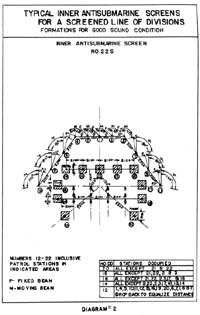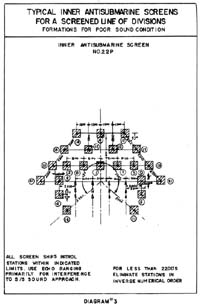|
|
(4) |
Dependent on the amount of the course change and whether Sound Screen Supports are available, the process of reorientation may consist of one of, or any combination of the following: |
|
|
|
(a) |
Uniform angular rotation of the screen. |
|
|
|
(b) |
Extension of the screen by use of the Sound Screen Supports. |
|
|
|
(c) |
Shifting of screening units from one end of the Screen to the other end. |
| |
| 1011. |
THE SCREENING INTERVAL of the Intermediate and Outer Antisubmarine Screen is normally prescribed diagramatically for each fleet cruising disposition. When not so prescribed these screening intervals will be ordered by signal. |
| |
| 1012. |
ZIGZAGGING. — Ships of the Inner and Intermediate Antisubmarine Screen will conform to the zigzag plan being executed by the force screened, whether or not ships of the Screen are patrolling their stations, and will keep clear of ships of the force screened at all times. Ships of the Outer Antisubmarine Screen will conform in general to the zigzag plan being executed by the force screened, but will use such modifications of this zigzag plan as are necessary to avoid interference with effective sound search operations. |
| |
| 1013. |
Ships of the Inner Antisubmarine Screen, which generally conform to the zigzagging of the force screened, will preserve the approximate true bearing of their stations (center of patrol area for patrolling vessels) from the nearest ship of the force screened, except in the case of screening a single ship with less than 4 screening ships, when relative bearings are to be maintained. |
| |
| 1014. |
SIGHTING OR DETECTING SUBMARINE BY A SHIP OF THE ANTISUBMARINE SCREEN.
Make the appropriate submarine emergency signal and then follow detailed procedure outlined in F. T. P. 219 (Par. 2302 etc.). |
| |
| 1015. |
APPROACH AND CONTACT DISPOSITIONS. — When an approach or contact disposition is formed from a cruising disposition in which Antisubmarine Screens are employed, the Screens will, unless otherwise ordered, proceed as directed in this article. Inner Antisubmarine Screens of the battle line, aircraft carriers and train continue to operate as Inner Antisubmarine Screens. All other vessels employed as Antisubmarine Screens proceed to stations for disposition ordered. |
| |
| 1016. |
DEPLOYMENT. — When deployment is ordered from a cruising, approach or contact disposition in which Antisubmarine Screens are employed, the Screens will, unless otherwise ordered, join the task forces to which they are assigned for battle. |
| |
| 1017. |
TO FORM AN ANTISUBMARINE SCREEN. —
SIGNALS REQUIRED: |
|
(a) |
Appropriate signal to form type of screen desired. (TACK numerals may be added to identify the plan). |
|
(b) |
Appropriate signal for forming single or double line screen on arc or on straight or broken line. |
|
NOTE: |
For the Inner Antisubmarine Screens in these instructions the stations to be occupied are indicated in diagrams and tables accompanying each diagram. |
| |
|
MOVEMENTS REQUIRED:
Ships of screening unit(s) take flank speed and proceed by most direct route to screening station keeping clear of heavy ships. For Inner Antisubmarine Screens in these instructions, stations will be occupied in accordance with the table accompanying each diagram, depending on the number of ships available. |


